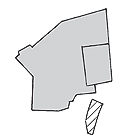The Early Periods, 3000-1000 BCE
|

|
The first permanent occupation in Jerusalem was in the Chalcolithic period (fourth millennium BCE) with the establishment of a permanent settlement near the Gihon Spring, and particularly during the Middle Bronze Age (third millennium BCE). In the nineteenth and eighteenth centuries BCE, as well as in the thirteenth century BCE, Jerusalem was a Canaanite city (it reverted to the Canaanites after the city was conquered by Joshua) and later it became a Jebusite city. The city's territory included the southeastern hill that is today called the City of David and which was enclosed within a wall. This wall, which dates to the eighteenth century BCE, is Jerusalem's earliest fortification.
Finds:
Remains of the city's fortifications were discovered along the eastern slope of the hill and include a section of a wall, a gate and a tower that are probably the "spring gate" (eighteenth century BCE). Finds from the early periods, especially from the Canaanite-Jebusite phase prior to the conquest of the city by David (Late Bronze Age, fifteenth-thirteenth centuries BCE), were discovered in Yigal Shiloh's excavations at the City of David and before that in Kathleen Kenyon's excavations.
Historical Sources:
It was in this period that Jerusalem was first mentioned in historical documents (ancient execration texts from the nineteenth century BCE) and in the El-Amarna letters (fourteenth century BCE).
Remarks:
Parts of the northern wall were apparently also discovered; however, because of the thickness of the walls that were exposed in the region on the northern side and the fact that the excavation was covered over, there is some doubt regarding the ascription of the finds.
|
|

| The Canaanite and Jebusite city |
|















